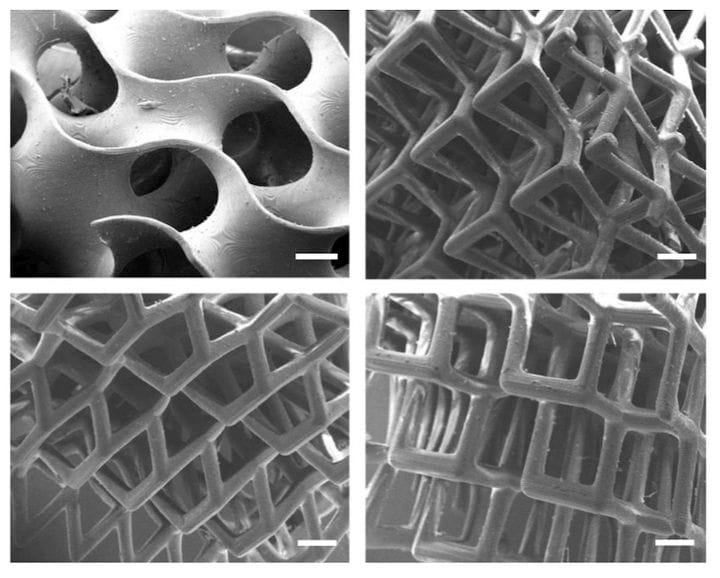![Microscopic 3D printed piezoelectric structures [Source: Nature]](https://fabbaloo.com/wp-content/uploads/2020/05/image-asset_img_5eb09e269c797.jpg)
Researchers have developed highly useful new approaches for 3D printing piezoelectric materials.
Piezeoelectricity, if you are not familiar, is an unusual property of some materials in which a small amount of electricity is generated when pressure is applied. These materials have been used in the past to manufacture key components of switches, sensors and the like.
But it’s a rather coarse phenomenon, as the electricity is generated largely from the microscopic crystalline structure of the piezoelectric substance. In other words, you get what you get.
Attempts have been made to modify the piezoelectric properties in the past, as the Virginia Tech researchers explain:
“Chemical modifications such as doping have been introduced to change the piezoelectric constants in certain directions by altering the crystallographic structures, but their design space is restricted by the limited set of doping agents. It also comes at the cost of other coupled physical properties such as mechanical flexibility and sensitivity. Casting and templating techniques have been used to produce piezoelectric foams that showcase the potential for reduced mass densities and improved hydrostatic figures of merit, but their piezoelectric coefficients, described by a square foam model, are largely limited by the intrinsic crystalline orientation and occupy only a narrow area within piezoelectric anisotropy space.”
Is there a better way to do this? It turns out, yes, there is, through 3D printing. They explain further:
“Here we report a set of concepts in which a wealth of direct piezoelectric responses can be generated through rationally designed piezoelectric architectural units and are realized via additive manufacturing of highly sensitive piezo-active lattice materials.”
They were able to design physical structures that enabled different types of piezoelectric behavior and produced a family of “structural node units” that enable them to “generate and manipulate a set of electric displacement maps with a given pressure, thereby achieving full control of piezoelectric constant tensor signatures.”
![Method and apparatus used to produce the controllable 3D printed piezoelectric structures [Source: Nature]](https://fabbaloo.com/wp-content/uploads/2020/05/image-asset_img_5eb09e26efa05.jpg)
In other words, they seem to have tamed the piezoelectric beast. It appears they are able, using appropriate combinations of these units, to produce literally any desired piezoelectric behavior. This is perhaps the most unusual metamaterial we’ve yet encountered.
It’s not clear from their paper exactly which type of 3D printer was used to produce their experimental metamaterials, and it seems they made their own device for this experiment. However, they do describe producing the base materials chemically and then using a photopolymer resin solidified by ultraviolet light, a common 3D printing process. The resolution required, however, must have been considerable.
What does this mean? They explain:
”We see this work as a step towards rationally designed 3D transducer materials in which users can design, amplify or suppress any operational modes for target applications. Design and tessellation of the piezo-active units can lead to a variety of smart-material functionalities, including vector and tactile sensing, source detection, acoustic sensing and strain amplifications from a fraction of their parent materials.“
To me, this is a significant step forward, as it allows, in theory, the ability to 3D print different kinds of electronic switches and sensors. When combined with other 3D printing processes, this could help enable the ability to literally 3D print functional electronic objects.
Via Nature











A research thesis details the incredibly complex world of volumetric 3D printing. We review the highlights.